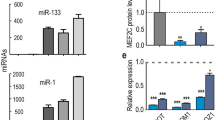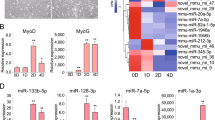Abstract
Gradients of signalling and transcription factors govern many aspects of embryogenesis, highlighting the need for spatiotemporal control of regulatory protein levels. MicroRNAs are phylogenetically conserved small RNAs that regulate the translation of _target messenger RNAs, providing a mechanism for protein dose regulation. Here we show that microRNA-1-1 (miR-1-1) and miR-1-2 are specifically expressed in cardiac and skeletal muscle precursor cells. We found that the miR-1 genes are direct transcriptional _targets of muscle differentiation regulators including serum response factor, MyoD and Mef2. Correspondingly, excess miR-1 in the developing heart leads to a decreased pool of proliferating ventricular cardiomyocytes. Using a new algorithm for microRNA _target identification that incorporates features of RNA structure and _target accessibility, we show that Hand2, a transcription factor that promotes ventricular cardiomyocyte expansion, is a _target of miR-1. This work suggests that miR-1 genes titrate the effects of critical cardiac regulatory proteins to control the balance between differentiation and proliferation during cardiogenesis.
This is a preview of subscription content, access via your institution
Access options
Subscribe to this journal
Receive 51 print issues and online access
We are sorry, but there is no personal subscription option available for your country.
Buy this article
- Purchase on SpringerLink
- Instant access to full article PDF
Prices may be subject to local taxes which are calculated during checkout




Similar content being viewed by others
References
He, L. & Hannon, G. J. MicroRNAs: small RNAs with a big role in gene regulation. Nature Rev. Genet. 5, 522–531 (2004)
Ambros, V. The functions of animal microRNAs. Nature 431, 350–355 (2004)
Meister, G. & Tuschl, T. Mechanisms of gene silencing by double-stranded RNA. Nature 431, 343–349 (2004)
Lee, R. C., Feinbaum, R. L. & Ambros, V. The C. elegans heterochronic gene lin-4 encodes small RNAs with antisense complementarity to lin-14. Cell 75, 843–854 (1993)
Wightman, B., Ha, I. & Ruvkun, G. Posttranscriptional regulation of the heterochronic gene lin-14 by lin-4 mediates temporal pattern formation in C. elegans. Cell 75, 855–862 (1993)
Moss, E. G., Lee, R. C. & Ambros, V. The cold shock domain protein LIN-28 controls developmental timing in C. elegans and is regulated by the lin-4 RNA. Cell 88, 637–646 (1997)
Brennecke, J., Hipfner, D. R., Stark, A., Russell, R. B. & Cohen, S. M. bantam encodes a developmentally regulated microRNA that controls cell proliferation and regulates the proapoptotic gene hid in Drosophila. Cell 113, 25–36 (2003)
Abrahante, J. E. et al. The Caenorhabditis elegans hunchback-like gene lin-57/hbl-1 controls developmental time and is regulated by microRNAs. Dev. Cell 4, 625–637 (2003)
Johnston, R. J. & Hobert, O. A microRNA controlling left/right neuronal asymmetry in Caenorhabditis elegans. Nature 426, 845–849 (2003)
Vella, M. C., Choi, E. Y., Lin, S. Y., Reinert, K. & Slack, F. J. The C. elegans microRNA let-7 binds to imperfect let-7 complementary sites from the lin-41 3′UTR. Genes Dev. 18, 132–137 (2004)
Chang, S., Johnston, R. J. Jr, Frokjaer-Jensen, C., Lockery, S. & Hobert, O. MicroRNAs act sequentially and asymmetrically to control chemosensory laterality in the nematode. Nature 430, 785–789 (2004)
Chien, K. R. & Olson, E. N. Converging pathways and principles in heart development and disease: CV@CSH. Cell 110, 153–162 (2002)
Srivastava, D. & Olson, E. N. A genetic blueprint for cardiac development. Nature 407, 221–226 (2000)
Norman, C., Runswick, M., Pollock, R. & Treisman, R. Isolation and properties of cDNA clones encoding SRF, a transcription factor that binds to the c-fos serum response element. Cell 55, 989–1003 (1988)
Miralles, F., Posern, G., Zaromytidou, A. I. & Treisman, R. Actin dynamics control SRF activity by regulation of its coactivator MAL. Cell 113, 329–342 (2003)
Shin, C. H. et al. Modulation of cardiac growth and development by HOP, an unusual homeodomain protein. Cell 110, 725–735 (2002)
Chen, F. et al. Hop is an unusual homeobox gene that modulates cardiac development. Cell 110, 713–723 (2002)
Yelon, D. et al. The bHLH transcription factor Hand2 plays parallel roles in zebrafish heart and pectoral fin development. Development 127, 2573–2582 (2000)
Srivastava, D., Cserjesi, P. & Olson, E. N. A subclass of bHLH proteins required for cardiac morphogenesis. Science 270, 1995–1999 (1995)
Srivastava, D. et al. Regulation of cardiac mesodermal and neural crest development by the bHLH transcription factor, dHAND. Nature Genet. 16, 154–160 (1997)
Firulli, A. B., McFadden, D. G., Lin, Q., Srivastava, D. & Olson, E. N. Heart and extra-embryonic mesodermal defects in mouse embryos lacking the bHLH transcription factor Hand1. Nature Genet. 18, 266–270 (1998)
Yamagishi, H. et al. The combinatorial activities of Nkx2.5 and dHAND are essential for cardiac ventricle formation. Dev. Biol. 239, 190–203 (2001)
McFadden, D. G. et al. The Hand1 and Hand2 transcription factors regulate expansion of the embryonic cardiac ventricles in a gene dosage-dependent manner. Development 132, 189–201 (2005)
Wang, D. et al. Activation of cardiac gene expression by myocardin, a transcriptional cofactor for serum response factor. Cell 105, 851–862 (2001)
Lee, R. C. & Ambros, V. An extensive class of small RNAs in Caenorhabditis elegans. Science 294, 862–864 (2001)
Lagos-Quintana, M., Rauhut, R., Lendeckel, W. & Tuschl, T. Identification of novel genes coding for small expressed RNAs. Science 294, 853–858 (2001)
Kelly, R. G. & Buckingham, M. E. The anterior heart-forming field: voyage to the arterial pole of the heart. Trends Genet. 18, 210–216 (2002)
Miano, J. M. et al. Restricted inactivation of serum response factor to the cardiovascular system. Proc. Natl Acad. Sci. USA 101, 17132–17137 (2004)
Wang, Z. et al. Myocardin and ternary complex factors compete for SRF to control smooth muscle gene expression. Nature 428, 185–189 (2004)
Wang, D. Z. & Olson, E. N. Control of smooth muscle development by the myocardin family of transcriptional coactivators. Curr. Opin. Genet. Dev. 14, 558–566 (2004)
Zhou, J. & Herring, B. P. Mechanisms responsible for the promoter-specific effects of myocardin. J. Biol. Chem. 280, 1086–1089 (2005)
Lai, E. C. Micro RNAs are complementary to 3′ UTR sequence motifs that mediate negative post-transcriptional regulation. Nature Genet. 30, 363–364 (2002)
Stark, A., Brennecke, J., Russell, R. B. & Cohen, S. M. Identification of Drosophila microRNA _targets. PLoS Biol. 1, E60 (2003)
Lewis, B. P., Shih, I. H., Jones-Rhoades, M. W., Bartel, D. P. & Burge, C. B. Prediction of mammalian microRNA _targets. Cell 115, 787–798 (2003)
Kiriakidou, M. et al. A combined computational-experimental approach predicts human microRNA _targets. Genes Dev. 18, 1165–1178 (2004)
John, B. et al. Human MicroRNA _targets. PLoS Biol. 2, e363 (2004)
Lewis, B. P., Burge, C. B. & Bartel, D. P. Conserved seed pairing, often flanked by adenosines, indicates that thousands of human genes are microRNA _targets. Cell 120, 15–20 (2005)
Rhoades, M. W. et al. Prediction of plant microRNA _targets. Cell 110, 513–520 (2002)
Yekta, S., Shih, I. H. & Bartel, D. P. MicroRNA-directed cleavage of HOXB8 mRNA. Science 304, 594–596 (2004)
Poy, M. N. et al. A pancreatic islet-specific microRNA regulates insulin secretion. Nature 432, 226–230 (2004)
Lee, N. S. et al. Expression of small interfering RNAs _targeted against HIV-1 rev transcripts in human cells. Nature Biotechnol. 20, 500–505 (2002)
Doench, J. G. & Sharp, P. A. Specificity of microRNA _target selection in translational repression. Genes Dev. 18, 504–511 (2004)
Bock-Marquette, I., Saxena, A., White, M. D., Dimaio, J. M. & Srivastava, D. Thymosin β4 activates integrin-linked kinase and promotes cardiac cell migration, survival and cardiac repair. Nature 432, 466–472 (2004)
Grosshans, H., Johnson, T., Reinert, K. L., Gerstein, M. & Slack, F. J. The temporal patterning microRNA let-7 regulates several transcription factors at the larval to adult transition in C. elegans. Dev. Cell 8, 321–330 (2005)
Haley, B. & Zamore, P. D. Kinetic analysis of the RNAi enzyme complex. Nature Struct. Mol. Biol. 11, 599–606 (2004)
Doench, J. G., Petersen, C. P. & Sharp, P. A. siRNAs can function as miRNAs. Genes Dev. 17, 438–442 (2003)
Dsouza, M., Larsen, N. & Overbeek, R. Searching for patterns in genomic data. Trends Genet. 13, 497–498 (1997)
Zuker, M. Mfold web server for nucleic acid folding and hybridization prediction. Nucleic Acids Res. 31, 3406–3415 (2003)
Yamagishi, H. et al. Tbx1 is regulated by tissue-specific forkhead proteins through a common Sonic hedgehog-responsive enhancer. Genes Dev. 7, 269–281 (2003)
Acknowledgements
We wish to thank K. Ivey for critical discussions and for preparation of figures; members of the Srivastava laboratory for helpful discussions; J. McAnally for generation of transgenic mice; E. N. Olson for plasmids; and R. Misra and R. Balza for providing SRF-null embryonic heart cDNA. D. S. was supported by grants from NHLB/NIH, the March of Dimes Birth Defects Foundation and the American Heart Association.
Author information
Authors and Affiliations
Corresponding author
Ethics declarations
Competing interests
MicroRNA 1 sequences have been deposited in Genbank under the following accession numbers: DQ066648 and DQ 066649 (Pan troglodytes pre-microRNA-1-1 and 1-2), DQ066650 (rat pre-microRNA-1), DQ066651 (Danio rerio pre-microRNA-1) and DQ066652 (Xenopus tropicalis pre-microRNA-1). Reprints and permissions information is available at npg.nature.com/reprintsandpermissions. The authors declare no competing financial interests.
Supplementary information
Supplementary Figure S1
Processed miR-1 is 21bp in length. This figure shows that endogenous mature form of miR-1 in skeletal muscle and heart is 21bp. (DOC 362 kb)
Supplementary Figure S2
Alignment of known microRNA _targets from different species. This figure shows that virtually all low δG sites are completely conserved, whereas high δG sites have variances in the sequence matching the critical 5' region of the miRNA. (DOC 100 kb)
Supplementary Figure S3
Conserved miR-1 _target sites in Hand2, TB4 and IGF1 3' UTRs. This figure shows sequence complementarity between miR-1 and 3' UTRs of Hand2, TB4 and IGF1 . (DOC 23 kb)
Supplementary Figure S4
miR-1 _target validation. This figure shows successful expression of mutant miR-1. Wild type or mutant miR-1s can repress the corresponding 3'UTRs or their mutant forms, respectively. (DOC 421 kb)
Supplementary Figure S5
Transgenic overexpression of αMHC-miR-1. This figure shows that miR-1 can be successfully highly expressed in heart in vivo under control of an alpha-MHC promoter. (DOC 247 kb)
Rights and permissions
About this article
Cite this article
Zhao, Y., Samal, E. & Srivastava, D. Serum response factor regulates a muscle-specific microRNA that _targets Hand2 during cardiogenesis. Nature 436, 214–220 (2005). https://doi.org/10.1038/nature03817
Received:
Accepted:
Issue Date:
DOI: https://doi.org/10.1038/nature03817
This article is cited by
-
Integrated modeling framework reveals co-regulation of transcription factors, miRNAs and lncRNAs on cardiac developmental dynamics
Stem Cell Research & Therapy (2023)
-
SRF: a seriously responsible factor in cardiac development and disease
Journal of Biomedical Science (2022)
-
AK098656: a new biomarker of coronary stenosis severity in hypertensive and coronary heart disease patients
Diabetology & Metabolic Syndrome (2022)
-
microRNA-148a in Exosomes Derived from Bone Marrow Mesenchymal Stem Cells Alleviates Cardiomyocyte Apoptosis in Atrial Fibrillation by Inhibiting SMOC2
Molecular Biotechnology (2022)
-
Sox6, A Potential _target for MicroRNAs in Cardiometabolic Disease
Current Hypertension Reports (2022)



